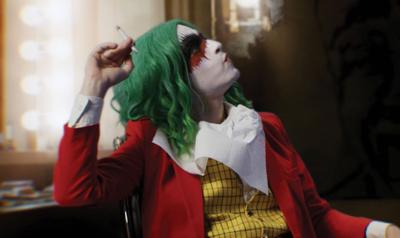The road to bringing Vera Drew’s vision of Gotham City to Nashville was paved with a few potholes. After receiving a strongly worded letter from Warner Bros. — who objected to her use of the media giant’s intellectual property the day before her premiere at the 2022 Toronto International Film Festival — the allegory about coming into her identity as a trans woman, told through the origin of DC Comics' most iconic villain, was barred from any further screenings for a year-and-a-half. In 2024, The People’s Joker was freed, allowing general audiences to witness Drew’s debut as writer-director-star of a multimedia, pop-cultured-saturated, psychedelic hyphenate of superhero parody, memoir and satire.
Before stopping at the Belcourt Wednesday for a post-screening Q&A, Drew spoke with the Scene about reimagining the Joker, breaking genre conventions, and how the late David Lynch — and his beloved practice of transcendental meditation — helped her complete her first feature and set the stage for what comes next. Our interview has been edited for length and clarity.
You’ve said before that the Joker was the perfect stand-in for telling your life story. But when you were writing it, were there parts of the Joker’s mythology that felt at odds with your story?
Honestly, just the fundamental fact that Joker is pretty much historically thought of as a villain, and a violent one too. That was maybe the only spot where there was some finessing that had to happen. I obviously couldn’t just make her an outright terrorist, because the Joker usually is. I leaned into the comedy anarchy; she’s trying to exist as an artist in a way that’s an affront to the mainstream world she’s in. The benefit of having two Jokers in it — Mr. J, her boyfriend, let me save the more direct, violent anarchy for him. We were playing with the Jared Leto Joker look. That’s why he’s lying in the last shot surrounded by a circle of guns. It made sense for the toxic edgelord leftist trope we were making with him.
I’ve never seen anything like The People’s Joker visually. How did you start laying out all the multimedia elements?
We wrote the script just like you’d write any big comic book movie: huge set pieces, car chases, a musical number at the end, going through every set piece again with a puppet character flying around. My co-writer Bri LeRose and I would always hit a point where we’d ask, “How are we going to pull this off?” We wrote with no budget rules, which I don’t recommend; it could have failed. But I knew from the beginning it would have this scrappy, mixed-media collage approach.
When it came time to make it, it was about the team we had. I’d assembled this small community of artists from different disciplines. It was pretty intuitive. We had someone who makes low-poly models that look like old PlayStation games, so we did that for the Batcave and Batmobile. Joker’s apartment needed to look exactly like Joaquin Phoenix Joker’s, but with our own spin, different art, different colors. That was our more realistic 3D model, done by Paul McBride. He wasn’t even doing 3D art professionally, just as a hobby. It was equal parts pragmatic and what made sense creatively.
You dedicate the film to Joel Schumacher, and his Batman films are referenced heavily throughout The People’s Joker. Were there other sources of inspiration that might be less obvious?
Many. Natural Born Killers, for the way it mixes film stocks and styles — that was always in my head as the bar for how far you could push form before losing the viewer. Pink Floyd: The Wall, the movie version, was another, because it’s structured like a dream happening inside the main character. I kept coming back to that, especially in how we use music. Scorsese movies like Goodfellas and The Wolf of Wall Street, too. The way they tell a story over time with pop music and flashy camera moves. The other big one was Hedwig and the Angry Inch. I always thought of The People’s Joker like a quasi-one-woman show. Hedwig started that way, and it’s about identity and media — set against the Berlin Wall, it has all the elements this movie has.
The Belcourt is screening The People’s Joker in its Queer Qlassics series. You’ve expressed frustration in the past at queer films being lumped into a separate category. Do you think it feels at home being screened alongside films like D.E.B.S. and Brokeback Mountain?
It depends on the day you ask me. When I was making it, I knew I was trans and queer and deeply gay, but I was really thinking of it as a genre movie, a comic book movie. Our first premiere at the Toronto International Film Festival was in their midnight movie category. I think the majority of the people who saw it that night were cis and straight people. It wasn’t until later, once people started writing about it, that the idea of me being even a “Queer Filmmaker” in capital letters crossed my mind.
Comedian talks growing up in Nashville and the Belcourt premiere of his new movie
I’m not put off by it, but I never wanted it to be limiting for me or anybody else. The People’s Joker came out around the same time as Stress Positions and I Saw the TV Glow — three movies by trans directors that couldn’t be more different. The jokes and tone are completely different. I like being part of a community, though. As a queer filmmaker, I have artists with similar life experiences I can turn to for help, and I do when I can.
The superhero genre has been described as dying, and you took it and breathed life into it. Was fatigue from the genre something on your mind when choosing to create a film using Batman characters?
I think I was trying to kill the genre completely, to be honest, or at least raise the bar for what it could be. By the time my movie came out, the most interesting mainstream superhero movies I thought about were the Sam Raimi Spider-Man movies; those have artistry and perspective that most Marvel movies don’t. I like Zack Snyder’s superhero movies too. Batman v. Superman is underrated. People talk so much shit about his Batman and Superman movies, but they’re fantastic. He’s clearly obsessed with fitness and rugged individualism, and it really shows. That’s why they work; he’s putting himself in there.
I never wanted this to be the “queer version” of these characters. I wanted it to show what happens when you inject your personality into them. James Gunn kind of does that too. I probably won’t see his new Superman movie though, mostly because he never responded to me when I tried to reach out about The People’s Joker. I saw Guardians of the Galaxy 10 times in theaters, dude. If you’re going to ignore me, I’m probably not going to see your movies anymore. But I wish him the best.
You wrote a post about David Lynch’s passing that was deeply moving. In it you mentioned Lynch inspired you to try transcendental meditation to finish The People’s Joker. Could you elaborate a bit on the role it played in your creative process?
In March 2022, I knew I had to have The People’s Joker done within five or six months. It was so far from done, none of the green screen was finalized, the score wasn’t done, and narration wasn’t figured out. I was a mental mess. I’d gotten an ADHD diagnosis, tried microdosing certain chemicals to help my mood and focus, and was a daily weed smoker, which certainly didn’t help. I had reached this peak of stress and worry, and also real spiritual bankruptcy. I read about Lynch losing his mind making Eraserhead until he found TM.
I’d thought TM seemed like a cult or something, but I looked into it and realized it’s just ancient Hindu meditation, basically, ancient technology that has worked for thousands of years. You sit there with a mantra for 20 minutes. Hearing Lynch demystify it finally got me to try it. They offered a sliding scale, and I hadn’t worked in years, so I got it cheap. It changed my life instantly. I remember driving home from the lesson and looking at Mount Wilson, it looked clearer than it ever had in my life after living out here for almost 15 years.
One thing I was stuck on was the narration. I had no idea where [the Joker] would be when telling the story. After meditating, I got this image: She’s inside a mirror cloud, this crystalline, solid-state cloud thing. That would never have come to me without meditation. Doing TM twice a day helped everything: my recovery, my stress, my art. I see why it meant so much to him. He really thought it would save the world. To be honest, I don't disagree with him. I do think if people meditated, whether it's TM or breath work, the world would change.
The People’s Joker obviously has a ton of humor. But at its core, there is so much heart and earnestness. Do you have any favorite reactions from people who’ve seen it?
Too many to even list. The first person who came up to me after our first screening was the mother of a trans woman. She thanked me for making something that helped her know how to talk to her daughter. That was insane and beautiful. I’ve had people say, “This movie finally cracked my egg. I feel ready to come out.” And selfishly, my favorite comic book writer, Grant Morrison, loves the movie; I never could’ve expected that.
I feel really lucky. Not many people get to make something that they know has changed some people’s lives. I don’t know if I’ll ever replicate it, but I do love making art. One of my next films is probably just as, if not more, vulnerable than The People’s Joker, but from a different angle. We’ll see.
This film took a wild ride to get here in Nashville. You mentioned other films you’re making — do you think your next creative journey will be as crazy as The People’s Joker?
Not in the same way. It’s not sustainable. Maybe in a different way. What I hope is next is a movie called Dead Name. It’s about a trans woman who goes home for the first time since coming out and, through sex magic mishaps, conjures her pre-transition doppelganger. There are weird visual effects, monsters and bonkers shit in it. So creatively, it’ll be just as insane, but they’re my characters, so I won’t get sued.
I want to keep pushing myself in storytelling. I like the idea of being an innovator when it comes to visual effects, hopefully using LED panels and new filmmaking technologies that are at our fingertips, but in a way that’s ethical and not just generative AI slop.






